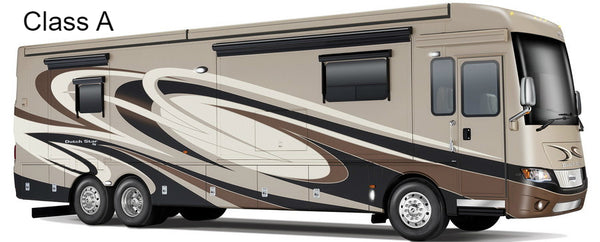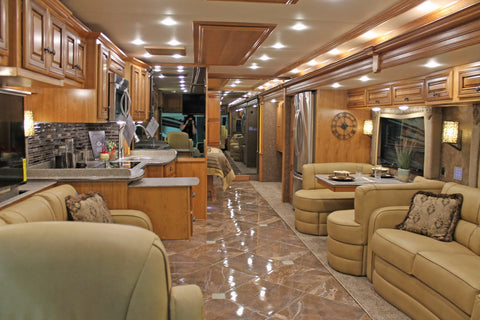RV Types
Class A Class B Class-C
Fifthwheel
Travel Trailer
Class A Motor Homes

If you take a stripped truck chassis, put a trailer on it, and alter the front so you can drive it down the road, you'll have a crude class A motor home. Another way of describing a class A motor home is that it's like a bus with living accommodations. Most manufacturers of class A motor homes buy chassis from an automotive manufacturer and then build the structure according to their design.
Advantages
The class A is popular because it's both a vehicle and a home in one self-contained package. Unlike a travel trailer, it provides easy access to living quarters from the driver's and passenger's seats. The feeling of openness — much like that of a fixed home — appeals to many RVers. Some like the class A because the height at the driver's seat affords an excellent view of road and traffic. The "boxlike" shape of a class A allows the builder to devise a variety of attractive floor plans that give the RV a homelike appeal. Because a class A is built on a chassis that comes without any body structure, a builder has a lot of latitude for establishing price range and quality.
Disadvantages
There are some negatives to owning a class A. Although a well-built class A is a pleasure to drive on straight roads, some people find longer motor homes more difficult to back up and turn in close places. The width of the driving compartment gives many RVers problems with judging right side clearance. Class A's have more structural problems than other types of RVs. The cockpit offers little protection to driver and passenger in accident situations.
Type of Use
Snowbirding and fulltiming with class A's should generally be limited to temperatures from approximately 30 degrees to 90 degrees Fahrenheit. Because of the large windshield area and, often, the large picture windows, we've found it's difficult to keep the interior comfortable at either extreme of the temperature range. We recommend drapes that wrap as tightly as possible to the windshield and side windows of the cockpit. If it is convenient to hang a drape from ceiling to floor behind the seats, we highly recommend it.

Cold weather camping requires heated holding tanks, a couple of small electric heaters, and excellent venting to keep moisture from collecting on the windows and walls. For boondocking you'll probably want to add a vented catalytic furnace.
If you expect to get caught in hot country, plan on two air conditioners for motor homes of 30 feet or longer. If you plan on boondocking in hot temperatures, you should also plan on a 6 kW generator, big exhaust fans in every vent, and lots of torque windows.
Cost Involved
When considering the purchase of a class A motor home, you should review your budget very carefully because this mode of RVing has the highest cost-per-mile factor. However, if you can afford it, you'll find that driving a quality class A motor home is an enjoyable way to see America.
Although class A motorhomes can be a pleasure to drive and live in, there are many things you need to consider to make a good choice. A bad choice increases your risk of accident, frustration, and severe financial loss. You need to choose a motor home that will fit your personality, budget, and tolerance for risk taking. With this in mind, let's take a look at some of the more serious problems of class A motor homes.
Look at Construction
Do not take for granted that a motor home built on a chassis by a reputable chassis manufacturer is a safe and efficient vehicle. Chassis manufacturers have very little control over RV manufacturers — many of whom are building poorly designed houses on reputable chassis. In one case we found evidence that an otherwise reputable motor home manufacturer underrated a chassis so they could promote a model with a higher-rated chassis. The problem here is that an underrated chassis has nowhere near the capacity to stop a motor home under normal loading and travel conditions. This is an unconscionable tactic, since it puts driver, passengers, and others on the highway in grave danger.

Motorhome Chassis
Although the class A's biggest problems by far are payload and wheelbase, the issues of width, length, and structural integrity are not far behind. Another black mark against the class A, however, is the mounting of an overhead television in the cockpit. Because it poses a serious threat in an accident situation, it doesn't make sense for a manufacturer to mount a heavy appliance over the heads of driver and passenger.
Length
Length is more of a safety and durability problem than a legal one. The biggest problem we've seen with length is the stretching of a motor home beyond the capabilities of the chassis. Extensions behind the rear wheels and stretching between front and rear axles are ways of putting a big house on a small foundation. Unless the motor home manufacturer is conscientious in the adaptation, stretching and extending can become serious safety issues. We have seen many extensions that are sloppily bolted or welded to the main chassis rails. We have reports of extensions that have failed sufficiently to cause cracking or breaking of the walls and roof structure. Stretching deficiencies are common with those manufacturers who are generally sloppy in other areas. When you find a reliability rating below 60 on any motorhome, you'll need to beware of extensions or stretches.
Width
Width is an extremely important subject when it comes to the selection of a class A. Motorhomes that are more than 102" wide are illegal on all highways. If an awning — or anything other than safety equipment (such as mirrors) — causes the vehicle to exceed the 102" width, the vehicle will be illegal. This means that almost all widebody RVs are illegal on all highways. Although law enforcement agencies do not appear to be issuing citations at this time, RVers should be cognizant of the fact that these RVs are considered to be illegal.
Structural Integrity
The structural integrity of a class A motor home should be the most important issue for the buyer but it rarely is. Our opinion is that close to 50% of class A motor homes are structurally unsound and will not sustain a collision at 20 miles per hour without serious damage to the coach and the occupants. In many models there is no steel bar to act as a bumper to prevent damage in low-speed collisions. The law requires this type of structure in automobiles and trucks but, apparently, the lives and property of RVers are not important enough to get the attention of the agencies involved in vehicle safety.
Structural integrity goes beyond chassis modifications and low-speed collision bars. We believe the biggest problem is that most motorhomes are incapable of sustaining a laydown at 50 miles per hour, let alone a rollover. Although we cannot support this opinion with enough statistics to satisfy many, we get little argument from those who know about the structure of class A motorhomes in general. The cutting of the wall for the addition of long slideout rooms — especially galley slideouts — has us deeply concerned about the ability of a motor home to sustain a laydown or rollover without serious consequences to driver and passengers. Although the class A motorhome accidents we have investigated do not paint a rosy picture, we are firmly convinced that a class A motor home with a highway control rating and reliability rating of a least 70 should be reasonably safe on the road and have enough structural integrity to provide driver and passenger(s) with some protection in an accident situation.
Wheel-to-base Ratio
The wheelbase issue has created contention between our organization and motorhome manufacturers because the manufacturers don't want limitations put on their marketing techniques. They want motor homes with wheelbases that can spin around on the sales lot and city traffic with ease. They want first- time buyers to jump into a motor home and drive it like the family car. They want the flexibility of adding floor plans and slideout rooms without extensive engineering to prevent overloading the front axle.
Wheelbase on a class A motorhome is a critical measurement. It is wheelbase that gives you stability on the highway. It is the lack of a good wheelbase that causes most motor homes to leave the highway. Theoretically, if you have an extra long wheelbase and lose your brakes on a long downhill grade, you would most probably hold to even a moderately curvy road at very fast speeds. With a short-wheelbase motor home, your chances of survival in such a scenario would undoubtedly be slim.

Although wheelbase is the primary factor for highway stability, many class A motorhomes are all over the road because they are overloaded on front or rear or both axles. Almost everyone we contact in the RV arena acknowledges that most class A motorhomes are close to capacity when they leave the factory. They acknowledge it but don't know what to do about it. The manufacturers are overloading the chassis for marketing purposes and they can do so with impunity. We've seen the proliferation of large slideouts and more and more heavy options even though many chassis cannot support the extra weight. It often appears that manufacturers are engaged in a race to continually upgrade their chassis fast enough to offset the addition of slideouts and options — and losing that race.

Most consumers do not understand that motor home chassis have very severe limitations when it comes to weight and balance. Most do not know that motor homes do not respond well to adverse road conditions when loaded to or beyond the capacity of the axles. Our advice is simple: Buy and use only motor homes that have highway safety ratings of at least 80. As you study the RV Ratings Guide, it should be clear that motor homes with ratings of less than 70 are not forgiving to mechanical failure or the small mistakes that we're apt to make when we're tired or distracted.
Choose Right
Whether it's a motorhome or a trailer, a home on wheels has its limitations — although there are some advantages if one can adjust to the lifestyle. It's your choice at the time of purchase that determines whether the adjustment will be difficult or easy.





